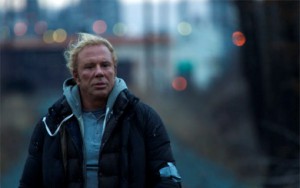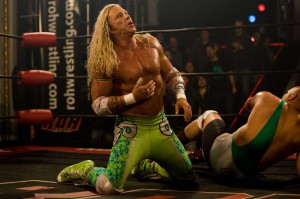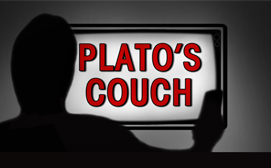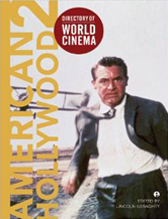
REVIEW: The Wrestler
American cinema revels in the comeback story. From Rocky (John G. Avildsen, 1976) and The Natural (Barry Levinson, 1984) through more recent fare such as Cinderella Man (Ron Howard, 2005), the celluloid history of Hollywood is underscored by a belief that anyone can make it big, fail, and then be resurrected again like a modern-day Lazarus. While nowadays the tabloid media delights in such personal tales with a predictable regularity (be they political, sporting or the rehabilitated B-grade celebrity), few individuals, and beyond that, films, would seem more worthy of such attention than Mickey Rourke and Darren Aronofsky’s The Wrestler.
A top-billing ‘rock-star’ wrestler of the late 1980s, Randy Robinson (Mickey Rourke) has seen better days. The long bleached locks and colourful lycra may remain, however “The Ram” (as he’s affectionately known) is now all but broke – locked out of his trailer home and living in the back of a van – and broken – his body on the verge of collapse.
 Looking back on a life of ever-quickening obscurity and given a glimpse of his mortality, Robinson begins to seek a life away from the lower echelons of the wrestling circuit to which his career has succumbed. Attempting to reconnect with his estranged daughter, Stephanie (Evan Rachel Wood), and setting his romantic sights on stripper-mom Cassidy (Marisa Tomei), The Wrestler holds up a redemptive path through its female characters to which Randy is hesitantly drawn.
Looking back on a life of ever-quickening obscurity and given a glimpse of his mortality, Robinson begins to seek a life away from the lower echelons of the wrestling circuit to which his career has succumbed. Attempting to reconnect with his estranged daughter, Stephanie (Evan Rachel Wood), and setting his romantic sights on stripper-mom Cassidy (Marisa Tomei), The Wrestler holds up a redemptive path through its female characters to which Randy is hesitantly drawn.
If at first glance the plot of The Wrestler seems like familiar territory, then on reflection Aronofsky’s film also stands apart from the bulk of Hollywood comeback tales. While the director does offer up Robinson as a kind of charismatic hero, he also has the conviction to depict his protagonist as a tired, abusive and forlorn figure at the same time.
It’s precisely that kind of moral ambiguity that lends The Wrestler its air of truthfulness, an achievement compounded by Rourke’s heartfelt portrayal of fallen stardom as Robinson goes from Wrestling God to ‘has been’ star to deli-counter nobody. And in his performance as ‘The Ram’, Rourke is nothing short of outstanding.
Exposing his battle-scarred body and reconstructed face with an extraordinary vulnerability, the likes of which hasn’t been seen since Robert De Niro piled on the pounds to capture the aging Jake La Motta’s in Martin Scorsese’s Raging Bull (1980), Rourke’s turn in front of the camera is one for the ages.
The similarities between Robinson and Rourke’s rags-to-riches-to-rags careers have already been well documented and yet part of the film’s success is no doubt the inseparability of the pair. It’s a sure sign of any good performance when the boundaries between actor and character become blurred, but here they become invisible. It’s as hard to imagine anyone else in this role as it is imagining a part that Rourke could be more suited to in the future.
In spite of his brilliance, the quality of The Wrestler doesn’t rest upon the bulky shoulders of Rourke alone. Marisa Tomei (continuing her own recent comeback form) and Evan Rachel Wood are both equally impressive in supporting roles. Far from serving as mere spectators to The Ram’s epiphanic wake-up, their characters provide a contemporary moral compass outside his character’s myopically nostalgic desire to re-live the glory days of the 1980s.
But The Wrestler is also more than just an ‘actor’s film’; it’s easily the strongest and most endearing work Aronofsky has ever helmed. If the strength of Rourke’s performance lies in the way he exposes himself to the camera, both physically and emotionally, then a similar observation could be made of The Wrestler’s direction.
Paring back the stylistic idiosyncrasies and self-indulgent quirks that characterised (and to some critics dogged) some of his earlier works (Requiem for a Dream 2000, The Fountain 2006) with The Wrestler Aronofsky announces himself as a thoughtful and maturing filmmaker. Demonstrating a heretofore unseen level of restraint, Aronowsky this time places his trust in the film’s story, script and performances, allowing the invariably raw and genuinely moving narrative to speak for itself unhindered by any superficial nuances.
 And true to his earnest style this time around, Aronowsky’s rag-tag wrestlers are a far cry from the surface glitz and glam of the modern-day WWE. Sure the fights might appear staged, but there’s nothing fake about these ‘school hall gladiators’ or the physicality of their bouts. In one stunning scene that plays out largely through flashbacks, The Ram’s body is subjected to a series of bloody assaults with objects ranging from a stapler and drawing pins to barbed wire and broken glass.
And true to his earnest style this time around, Aronowsky’s rag-tag wrestlers are a far cry from the surface glitz and glam of the modern-day WWE. Sure the fights might appear staged, but there’s nothing fake about these ‘school hall gladiators’ or the physicality of their bouts. In one stunning scene that plays out largely through flashbacks, The Ram’s body is subjected to a series of bloody assaults with objects ranging from a stapler and drawing pins to barbed wire and broken glass.
It’s perhaps not surprising then that at one point Cassidy draws the association between Randy’s war-torn physique and the opening title card (‘…by His wounds we are healed’) of Mel Gibson’s The Passion of the Christ (2004). But such comparisons tend to float across the surface of the film’s narrative. Unlike Gibson (or Scorsese too for that matter), the violence in The Wrestler largely avoids such densely religious connotations – Robinson is less a Christ figure striving for salvation than he is a punch-drunk yesterday’s hero trying to eke out the last bit of respect doing the only thing he’s ever known – ‘performing’ for a cheering crowd.
It’s interesting then, that unlike the ‘I was blind but now I see’ epitaph that Scorsese bestows upon La Motta at the end of his masterpiece, Aronofsky seems more restrained about the possible redemption of his protagonist. In The Wrestler’s final moments, ‘The Ram’ is captured in a conflicting moment of celebratory transcendence and pitiable self-annihilation. It’s the perfect finale for a film that deserves every bit of praise it has received, and will no doubt continue to receive for some time.





RSS feed for comments on this post. TrackBack URI